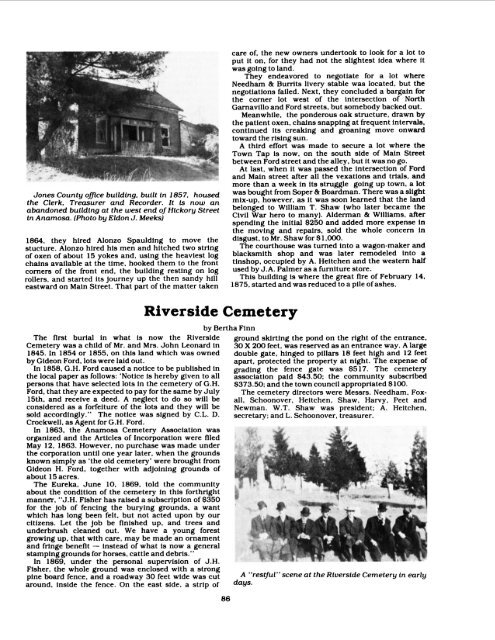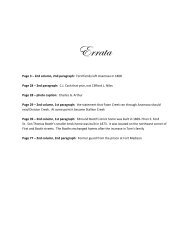Anamosa - A Reminiscence 1838 - 1988
The definitive history of the community of Anamosa, Iowa, USA
The definitive history of the community of Anamosa, Iowa, USA
You also want an ePaper? Increase the reach of your titles
YUMPU automatically turns print PDFs into web optimized ePapers that Google loves.
°“P<br />
Jones County office building, built in I857, housed<br />
the Clerk, Treasurer and Recorder. It is now an<br />
abandoned building at the west end of Hickory Street<br />
in <strong>Anamosa</strong>. (Photo by Eldon J. Meeks)<br />
1864. they hired Alonzo Spaulding to move the<br />
stucture. Alonzo hired his men and hitched two string<br />
of oxen of about 15 yokes and. using the heaviest log<br />
chains available at the time, hooked them to the front<br />
corners of the front end, the building resting on log<br />
rollers, and started its journey up the then sandy hill<br />
eastward on Main Street. That part of the matter taken<br />
care of, the new owners undertook to look for a lot to<br />
put it on, for they had not the slightest idea where it<br />
was going to land.<br />
They endeavored to negotiate for a lot where<br />
Needham & Burrits livery stable was located, but the<br />
negotiations failed. Next. they concluded a bargain for<br />
the corner lot west of the intersection of North<br />
Gamavillo and Ford streets, but somebody backed out.<br />
Meanwhile. the ponderous oak structure, drawn by<br />
the patient oxen, chains snapping at frequent intervals,<br />
continued its creaking and groaning move onward<br />
toward the rising sun.<br />
A third effort was made to secure a lot where the<br />
Town Tap is now. on the south side of Main Street<br />
between Ford street and the alley, but it was no go.<br />
At last, when it was passed the intersection of Ford<br />
and Main street after all the vexations and trials. and<br />
more than a week in its struggle going up town, a lot<br />
was bought from Soper 8: Boardman. There was a slight<br />
mix-up. however. as it was soon learned that the land<br />
belonged to William T. Shaw (who later became the<br />
Civil War hero to many). Alderman & Williams. after<br />
spending the initial $250 and added more expense in<br />
the moving and repairs. sold the whole concern in<br />
disgust, to Mr. Shaw for $1,000.<br />
The courthouse was turned into a wagon-maker and<br />
blacksmith shop and was later remodeled into a<br />
tinshop, occupied by A. Heitchen and the western half<br />
used by J .A. Palmer as a furniture store.<br />
This building is where the great fire of February 14.<br />
1875. started and was reduced to a pile of ashes.<br />
Riverside<br />
The first burial in what is now the Riverside<br />
Cemetery was a child of Mr. and Mrs. John Leonard in<br />
1845. In 1854 or 1855, on this land which was owned<br />
by Gideon Ford, lots were laid out.<br />
In 1858, G.H. Ford caused a notice to be published in<br />
the local paper as follows: ‘Notice is hereby given to all<br />
persons that have selected lots in the cemetery of G.H.<br />
Ford, that they are expected to pay for the same by July<br />
15th. and receive a deed. A neglect to do so will be<br />
considered as a forfeiture of the lots and they will be<br />
sold accordingly." The notice was signed by C.L. D.<br />
Crockwell, as Agent for G.H. Ford.<br />
In 1863, the <strong>Anamosa</strong> Cemetery Association was<br />
organized and the Articles of incorporation were filed<br />
May 12, 1863. However, no purchase was made under<br />
the corporation until one year later, when the grounds<br />
known simply as ‘the old cemetery‘ were brought from<br />
Gideon H. Ford, together with adjoining grounds of<br />
about 15 acres.<br />
The Eureka, June 10, 1869, told the community<br />
about the condition of the cemetery in this forthright<br />
manner, “J.H. Fisher has raised a subscription of $350<br />
for the job of fencing the burying grounds, a want<br />
which has long been felt, but not acted upon by our<br />
citizens. Let the job be finished up, and trees and<br />
underbrush cleaned out. We have a young forest<br />
growing up, that with care, may be made an ornament<br />
and fringe benefit — instead of what is.now a general<br />
stamping grounds for horses, cattle and debris."<br />
In 1869, under the personal supervision of J.H.<br />
Fisher, the whole ground was enclosed with a strong<br />
pine board fence, and a roadway 30 feet wide was cut<br />
around, inside the fence. On the east side, a strip of<br />
Cemetery<br />
by Bertha Finn<br />
ground skirting the pond on the right of the entrance.<br />
30 X 200 feet. was reserved as an entrance way. A large<br />
double gate, hinged to pillars 18 feet high and 12 feet<br />
apart, protected the property at night. The expense of<br />
grading the fence gate was $517. The cemetery<br />
association paid $43.50: the community subscribed<br />
$373.50; and the town council appropriated S 100.<br />
The cemetery directors were Messrs. Needham, Foxall,<br />
Schoonover, Heitchen, Shaw, Harvy, Peet and<br />
Newman. W.T. Shaw was president; A. Heitchen,<br />
secretary: and L. Schoonover, treasurer.<br />
“ 0 0 ‘ . ‘ .<br />
A "restful" scene at the Riverside Cemetery in early<br />
days.



